Stan C. Smith's Blog, page 32
July 11, 2018
Awesome Animal - Giant Centipede
You may have noticed that the business end of the weapon on the
Bridgers 3
cover looks very much like a large centipede. In honor of that organic, living weapon, today's awesome animal is the giant centipede.
Way back when Trish and I first met (1991, in case you're wondering), we would regularly go to the Flint Hills of eastern Kansas to hike and search for snakes and lizards. Yep, it has been that kind of romance from the beginning. In the process of lifting up flat limestone rocks, where reptiles like to hide, we would sometimes come across the "giant centipede." Some of these were FIVE inches long.
Now, I want to point out that giant centipedes are known to have a nasty, outrageously painful bite (although the ones in Kansas are certainly not fatal). And they look rather wicked. Here is a photo I took of one of the centipedes we found.
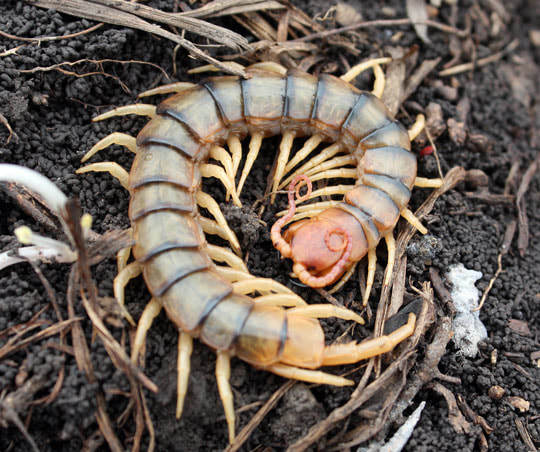
So one day we decided to capture the largest one we could find so that we could show it to our students (we both taught biology at the time). We took the centipede home in a plastic butter tub. When we got home, we decided to transfer the creature to a larger container. This did not go well. The centipede made a wild lunge at the stick I was using to coax it from one container to the next. This startled me (translation: I squealed like a little girl), and dropped the butter tub. The centipede took off across the living room floor and disappeared down a crack next to the stairs.
It was under the floorboards of the house. The house where we lived, and slept, and routinely walked around without shoes. We never saw the centipede again, but we found it somewhat more difficult to relax for several weeks after the centipede incident.
SIDE NOTE: You might be wondering why a little five-inch arthropod would startle me so much. After all, for many years I taught my students how to safely handle tarantulas and snakes. Well, everyone has that one creature that gives them the willies, right?
So what the heck is a Giant Centipede ?
For simplicity, I'm going to refer to all the larger centipedes of the genus Scolopendra as Giant Centipedes. Numerous species live around the world, particularly in tropical areas. The five-inch Tiger Centipede of Kansas (described above) is impressive, but some of the Scolopendra centipedes are truly awesome.
Amazing facts about Giant Centipedes
Giant centipedes are big (well, duh). How big? One of the largest, sometimes called the Amazonian Giant Centipede, grows to 12 inches (30 cm) in length. Yes, that's a foot long.

Giant centipedes, like all other centipedes, are predators. Living under rocks and in the leaf litter of forests, these creatures normally catch and eat other invertebrates (insects, spiders, scorpions, millipedes, snails). But they're not picky. They will eat anything small enough for them to subdue and kill. So the larger species often eat frogs, lizards, snakes, mice, small birds, and even bats. In fact, the Amazonian Giant Centipede is an expert at catching bats. They climb around upside down on the ceilings of caves to ambush bats. Once they kill one, they hang by a few of their hindmost legs while holding and feeding on the much larger bat.
Check out this video of a giant centipede attacking a bat.
And this one of a giant centipede preying on a tarantula.
Centipedes produce fast-acting venom. The two large "fangs" you see at the head end of a centipede are actually a modified pair of legs (called forcipules) for injecting venom into their prey. So, since these are modified legs instead of true mouthparts, centipedes do not actually "bite" (although the effect is the same). What's truly amazing about centipede venom is how fast it works. A giant centipede that weighs only 3g can immobilize a 45g mouse in less than 30 seconds. Centipede venom contains many nasty components, but a recent study indicates that the component that allows giant centipedes to kill large prey (such as bats and mice) is one that blocks potassium ion channels within nerve cells. This causes the nerves to fire repeatedly, throwing the heart and breathing system into disarray. This venom component was given the appropriate name of Spooky Toxin (SsTx).
Centipedes don't see well, so they use their sense of touch to catch prey. They have two multi-jointed, antennae. These antennae are highly sensitive to touch, and they are covered with chemoreceptors, allowing the centipedes to also "smell" their prey.
Despite their name, centipedes do not actually have 100 legs. They actually have one pair of legs for each body segment (millipedes have two pairs per segment). So some centipedes have as few as 14 legs, and some have as many as 177. The giant centipedes of the genus Scolopendra typically have 21 to 23 body segments (42 to 46 legs).
Okay, one more morsel of information to satisfy your burning curiosity. Giant centipedes are not considered as food for humans in most cultures. But in China, they are sometimes eaten grilled or deep fat fried and are usually served on skewers.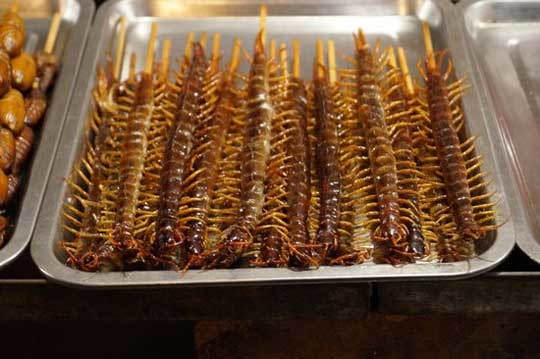
So, the giant centipede deserves a place in the F.A.H.O.F. (Funkadelic Animal Hall of Fame).
FUN FACT: The word funkadelic actually originated in the late 1960s as the name of an American band led by George Clinton. It combined the words funk and psychedelic. The word then became a broader term to describe the category of music this band pioneered, dance music that combines soul and funk with elements of rock. And... the word gradually began to be used to describe anything cool or spectacular. So, funkadelic is another way to say awesome!
Photo Credits:
Tiger Centipede - Stan C. Smith
Amazonian Centipede by hand - dimocritus via DeviantArt
Centipede Fangs - CrossTimber Naturalist
Centipede Skewers - TripAdvisor
Way back when Trish and I first met (1991, in case you're wondering), we would regularly go to the Flint Hills of eastern Kansas to hike and search for snakes and lizards. Yep, it has been that kind of romance from the beginning. In the process of lifting up flat limestone rocks, where reptiles like to hide, we would sometimes come across the "giant centipede." Some of these were FIVE inches long.
Now, I want to point out that giant centipedes are known to have a nasty, outrageously painful bite (although the ones in Kansas are certainly not fatal). And they look rather wicked. Here is a photo I took of one of the centipedes we found.

So one day we decided to capture the largest one we could find so that we could show it to our students (we both taught biology at the time). We took the centipede home in a plastic butter tub. When we got home, we decided to transfer the creature to a larger container. This did not go well. The centipede made a wild lunge at the stick I was using to coax it from one container to the next. This startled me (translation: I squealed like a little girl), and dropped the butter tub. The centipede took off across the living room floor and disappeared down a crack next to the stairs.
It was under the floorboards of the house. The house where we lived, and slept, and routinely walked around without shoes. We never saw the centipede again, but we found it somewhat more difficult to relax for several weeks after the centipede incident.
SIDE NOTE: You might be wondering why a little five-inch arthropod would startle me so much. After all, for many years I taught my students how to safely handle tarantulas and snakes. Well, everyone has that one creature that gives them the willies, right?
So what the heck is a Giant Centipede ?
For simplicity, I'm going to refer to all the larger centipedes of the genus Scolopendra as Giant Centipedes. Numerous species live around the world, particularly in tropical areas. The five-inch Tiger Centipede of Kansas (described above) is impressive, but some of the Scolopendra centipedes are truly awesome.
Amazing facts about Giant Centipedes
Giant centipedes are big (well, duh). How big? One of the largest, sometimes called the Amazonian Giant Centipede, grows to 12 inches (30 cm) in length. Yes, that's a foot long.

Giant centipedes, like all other centipedes, are predators. Living under rocks and in the leaf litter of forests, these creatures normally catch and eat other invertebrates (insects, spiders, scorpions, millipedes, snails). But they're not picky. They will eat anything small enough for them to subdue and kill. So the larger species often eat frogs, lizards, snakes, mice, small birds, and even bats. In fact, the Amazonian Giant Centipede is an expert at catching bats. They climb around upside down on the ceilings of caves to ambush bats. Once they kill one, they hang by a few of their hindmost legs while holding and feeding on the much larger bat.
Check out this video of a giant centipede attacking a bat.
And this one of a giant centipede preying on a tarantula.
Centipedes produce fast-acting venom. The two large "fangs" you see at the head end of a centipede are actually a modified pair of legs (called forcipules) for injecting venom into their prey. So, since these are modified legs instead of true mouthparts, centipedes do not actually "bite" (although the effect is the same). What's truly amazing about centipede venom is how fast it works. A giant centipede that weighs only 3g can immobilize a 45g mouse in less than 30 seconds. Centipede venom contains many nasty components, but a recent study indicates that the component that allows giant centipedes to kill large prey (such as bats and mice) is one that blocks potassium ion channels within nerve cells. This causes the nerves to fire repeatedly, throwing the heart and breathing system into disarray. This venom component was given the appropriate name of Spooky Toxin (SsTx).

Centipedes don't see well, so they use their sense of touch to catch prey. They have two multi-jointed, antennae. These antennae are highly sensitive to touch, and they are covered with chemoreceptors, allowing the centipedes to also "smell" their prey.
Despite their name, centipedes do not actually have 100 legs. They actually have one pair of legs for each body segment (millipedes have two pairs per segment). So some centipedes have as few as 14 legs, and some have as many as 177. The giant centipedes of the genus Scolopendra typically have 21 to 23 body segments (42 to 46 legs).
Okay, one more morsel of information to satisfy your burning curiosity. Giant centipedes are not considered as food for humans in most cultures. But in China, they are sometimes eaten grilled or deep fat fried and are usually served on skewers.

So, the giant centipede deserves a place in the F.A.H.O.F. (Funkadelic Animal Hall of Fame).
FUN FACT: The word funkadelic actually originated in the late 1960s as the name of an American band led by George Clinton. It combined the words funk and psychedelic. The word then became a broader term to describe the category of music this band pioneered, dance music that combines soul and funk with elements of rock. And... the word gradually began to be used to describe anything cool or spectacular. So, funkadelic is another way to say awesome!
Photo Credits:
Tiger Centipede - Stan C. Smith
Amazonian Centipede by hand - dimocritus via DeviantArt
Centipede Fangs - CrossTimber Naturalist
Centipede Skewers - TripAdvisor
Published on July 11, 2018 06:46
July 10, 2018
Bridgers 3: The Voice of Reason - Cover Reveal
For those who are fans of my
Bridgers
series, I'm pleased to say that
Bridgers 3
is almost complete! If all goes according to plan, it will be released in early August (maybe even August 1st).
The covers for the Bridgers series have a common theme... a grimy hand holding a weapon. The weapon is something the bridgers are forced to use in order to survive in an alternate version of Earth. Bridgers 1 features a primitive spear, Bridgers 2 has a bladed, copper mace.

Well, it's time to introduce the cover of BRIDGERS 3. This cover features the strangest, awesomest, scariest weapon yet... a venomcrook.

Bridgers 3: The Voice of Reason introduces a world unlike any the bridgers have ever imagined. Saving the human species is not as easy as you might think.
Only a few weeks away!
Not sure if you're interested in the Bridgers series? One way to find out is to read a free preview.
Read Chapter 1 of Bridgers 1: The Lure of Infinity
And you can get the full books here: Bridgers 1 , Bridgers 2 .
The covers for the Bridgers series have a common theme... a grimy hand holding a weapon. The weapon is something the bridgers are forced to use in order to survive in an alternate version of Earth. Bridgers 1 features a primitive spear, Bridgers 2 has a bladed, copper mace.

Well, it's time to introduce the cover of BRIDGERS 3. This cover features the strangest, awesomest, scariest weapon yet... a venomcrook.

Bridgers 3: The Voice of Reason introduces a world unlike any the bridgers have ever imagined. Saving the human species is not as easy as you might think.
Only a few weeks away!
Not sure if you're interested in the Bridgers series? One way to find out is to read a free preview.
Read Chapter 1 of Bridgers 1: The Lure of Infinity
And you can get the full books here: Bridgers 1 , Bridgers 2 .
Published on July 10, 2018 17:48
June 27, 2018
Awesome Animal - Giant Clam
Today's awesome animal is not one that makes an appearance in my novels. But, dang it, giant clams should be in one of my stories! Remember the old Tarzan movies (and other adventure tales) where the hero would swim to the ocean floor, only to have a giant clam clamp down on his leg? He would struggle to get loose, barely making it free before drowning.
So, giant clams have gotten a bad rap (at least in the old movies). But I don't think they deserve that.
When Trish and I snorkeled the Great Barrier Reef on our recent Australia trip, we saw a mind-boggling array of colorful fish and invertebrates. But even with all those amazing creatures there, my favorite was the giant clams.
So what the heck is a Giant Clam ?
Giant clams actually include about ten species of bivalve mollusks that live in warm, shallow waters of the Indian and South Pacific Oceans. They are the largest of all the bivalve mollusks (mollusks that have two shells, like clams, oysters, mussels, scallops, and others). Below is a giant clam I saw while snorkeling off the coast of Queensland, Australia. It was between two and three feet (.6 to .9 m) from end to end.

Amazing facts about the Giant Clam
Giant clams are, well, giant. They can grow to more than four feet (1.2 m) and weigh over 500 pounds (227 kg). Most of this weight, however, is the shell. The soft, living portion is only about 10% of the creature's weight. Although the body is only 10% of the weight, these soft tissues are almost entirely good, healthy protein, which is why giant clams have been hunted for centuries (maybe much longer). Due to hunting, giant clams are now at risk of becoming extinct. Fortunately, these clams can live to over 100 years old.
Giant clams do not eat people. Legends in the South Pacific describe giant clams waiting patiently for unsuspecting swimmers to come along so they can grab them and eat them whole. This is simply not true. There has never been a substantiated case of a human being killed by one of these gentle giants. In fact, the muscles that pull the shells closed move far too slowly to catch a swimmer by surprise.
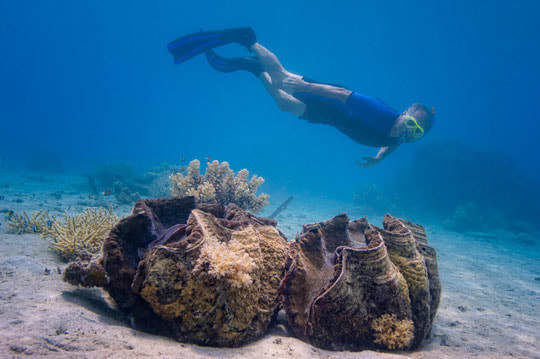
Giant clams are colorful. The portion of the live tissue you can see is called the mantle (I think of it as the clam's lips). The mantle is a different color for ever individual clam, and they can be brilliant greens, oranges, blues, or about any other color. This color is caused by iridocytes, which are cells that reflect light. Oddly, if you see a giant clam that looks green, if you swim to the other side and look at it from a different angle the color can change its hue.
These brilliant giant clam iridocytes are being closely studied by scientists who hope to develop improved cell phone screens. Most TV and cell phone screens today use their own source of backlighting. But reflected light is much easier on the eyes. Giant clam iridocytes are so good at reflecting different colors of light that these cells may hold clues to creating screens that reflect ambient light (instead of being backlit).
Check out this video of the colors of giant clams.
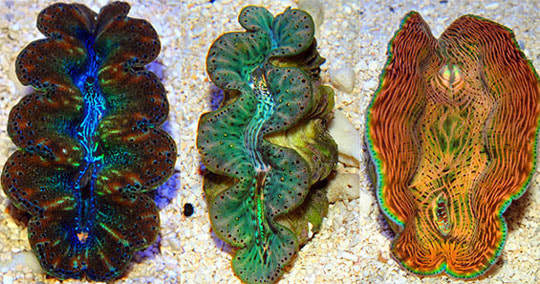
How do giant clams get so huge? Oddly, they obtain their food in several ways. Most of their food comes from the symbiotic algae that live in their cells (these algae are the source of the iridocytes' colors). So, the clams can use sunlight for photosynthesis (in which light is used to convert carbon dioxide into food/energy). Giant clams also feed on plankton by filtering it from the water. The nutrients from the plankton help feed the algae in the clam's cells. Complicated, huh?
One species of giant clam has perfected the ship-in-a-bottle trick. These clams, when relatively small, burrow into the stone-like surface of a coral reef. They end up with only their mantle (the "lips") showing. As they grow, they get too big to fit through the hole in the rock (although high acidity in a layer of tissue around their shells eats away at the surrounding rock so that their cavity grows as their shell grows). So for multiple decades of their life, they are trapped in the rock-hard reef. Below is a photo of one of these clams I found while snorkeling. All you can see is its lips.
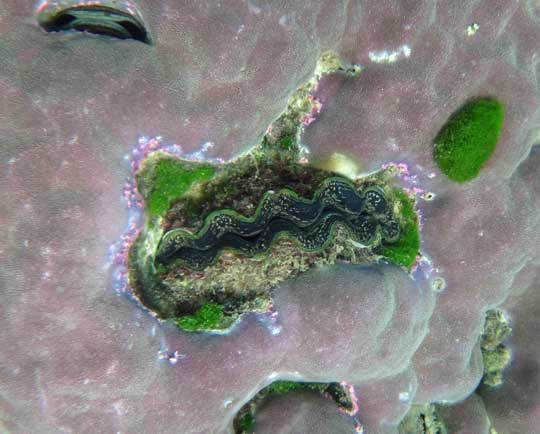
So, the giant clam deserves a place in the K.A.H.O.F. (Kryptonian Animal Hall of Fame).
FUN FACT: Okay, maybe this one's a bit of a stretch, but I like it. The word Kryptonian actually refers to the advanced race of aliens from the planet Krypton (you know... from Superman). Gradually it evolved into an adjective that describes anything associated with the planet or the race. And then (this is the part that might be based on my own wishful thinking), it evolved into an adjective to describe anything spectacular (the Kryptonians, including Superman, were spectacular, right?). So, in my opinion, kryptonian is another way to say awesome!
Photo Credits:
Giant Clam #1 - Stan C. Smith
Giant Clam and Snorkler - AvatarLogs.com
Giant Clam Different Colors - LiveAquaria
Giant Clam buried in Coral Rock - Stan C. Smith
So, giant clams have gotten a bad rap (at least in the old movies). But I don't think they deserve that.
When Trish and I snorkeled the Great Barrier Reef on our recent Australia trip, we saw a mind-boggling array of colorful fish and invertebrates. But even with all those amazing creatures there, my favorite was the giant clams.
So what the heck is a Giant Clam ?
Giant clams actually include about ten species of bivalve mollusks that live in warm, shallow waters of the Indian and South Pacific Oceans. They are the largest of all the bivalve mollusks (mollusks that have two shells, like clams, oysters, mussels, scallops, and others). Below is a giant clam I saw while snorkeling off the coast of Queensland, Australia. It was between two and three feet (.6 to .9 m) from end to end.

Amazing facts about the Giant Clam
Giant clams are, well, giant. They can grow to more than four feet (1.2 m) and weigh over 500 pounds (227 kg). Most of this weight, however, is the shell. The soft, living portion is only about 10% of the creature's weight. Although the body is only 10% of the weight, these soft tissues are almost entirely good, healthy protein, which is why giant clams have been hunted for centuries (maybe much longer). Due to hunting, giant clams are now at risk of becoming extinct. Fortunately, these clams can live to over 100 years old.
Giant clams do not eat people. Legends in the South Pacific describe giant clams waiting patiently for unsuspecting swimmers to come along so they can grab them and eat them whole. This is simply not true. There has never been a substantiated case of a human being killed by one of these gentle giants. In fact, the muscles that pull the shells closed move far too slowly to catch a swimmer by surprise.

Giant clams are colorful. The portion of the live tissue you can see is called the mantle (I think of it as the clam's lips). The mantle is a different color for ever individual clam, and they can be brilliant greens, oranges, blues, or about any other color. This color is caused by iridocytes, which are cells that reflect light. Oddly, if you see a giant clam that looks green, if you swim to the other side and look at it from a different angle the color can change its hue.
These brilliant giant clam iridocytes are being closely studied by scientists who hope to develop improved cell phone screens. Most TV and cell phone screens today use their own source of backlighting. But reflected light is much easier on the eyes. Giant clam iridocytes are so good at reflecting different colors of light that these cells may hold clues to creating screens that reflect ambient light (instead of being backlit).
Check out this video of the colors of giant clams.

How do giant clams get so huge? Oddly, they obtain their food in several ways. Most of their food comes from the symbiotic algae that live in their cells (these algae are the source of the iridocytes' colors). So, the clams can use sunlight for photosynthesis (in which light is used to convert carbon dioxide into food/energy). Giant clams also feed on plankton by filtering it from the water. The nutrients from the plankton help feed the algae in the clam's cells. Complicated, huh?
One species of giant clam has perfected the ship-in-a-bottle trick. These clams, when relatively small, burrow into the stone-like surface of a coral reef. They end up with only their mantle (the "lips") showing. As they grow, they get too big to fit through the hole in the rock (although high acidity in a layer of tissue around their shells eats away at the surrounding rock so that their cavity grows as their shell grows). So for multiple decades of their life, they are trapped in the rock-hard reef. Below is a photo of one of these clams I found while snorkeling. All you can see is its lips.

So, the giant clam deserves a place in the K.A.H.O.F. (Kryptonian Animal Hall of Fame).
FUN FACT: Okay, maybe this one's a bit of a stretch, but I like it. The word Kryptonian actually refers to the advanced race of aliens from the planet Krypton (you know... from Superman). Gradually it evolved into an adjective that describes anything associated with the planet or the race. And then (this is the part that might be based on my own wishful thinking), it evolved into an adjective to describe anything spectacular (the Kryptonians, including Superman, were spectacular, right?). So, in my opinion, kryptonian is another way to say awesome!
Photo Credits:
Giant Clam #1 - Stan C. Smith
Giant Clam and Snorkler - AvatarLogs.com
Giant Clam Different Colors - LiveAquaria
Giant Clam buried in Coral Rock - Stan C. Smith
Published on June 27, 2018 13:31
June 12, 2018
Awesome Animal - Kookaburra
Today's awesome animal is not one that makes an appearance in my novels, but it is one I've been thinking I should feature, especially since Trish and I saw so many of them on our Australia trip. Sometimes people can't resist describing certain animals as having personality. Well, the kookaburra is one of those that would definitely fall into the personality category.
So what the heck is a Kookaburra ?
Kookaburras are birds in the kingfisher family. They are the largest of the kingfishers, growing up to 17 inches (42 cm) long. There are four species of kookaburras, the most well-known of which is the laughing kookaburra. The kookaburra, like the wombat and the kangaroo, is an iconic animal of Australia, and it is worth knowing more about. Here is a laughing kookaburra Trish and I saw while on a walk:

Amazing facts about the Kookaburra
Perhaps the most striking characteristic of kingfishers is their vocalizations, and the kookaburra is king (and queen) of the kingfishers in this respect. The laughing kookaburra (which is the species we saw in northeast Queensland) is famous for its astoundingly-loud "laughing" call. On our trip to Australia, even if we had wanted to sleep past daybreak, the kookaburras would not have allowed it. At first light, they seem to get the overwhelming urge to let everything within a half mile know that they still haven't lost their sense of humor. Because of their regularity, they are sometimes called the bushman's clock.
Check out this video of a kookaburra laughing.
And this one!
Of course, they aren't really laughing when they do this. Instead, they are letting other birds know the boundaries of their territory. Kingfishers, in general, are territorial.
The kookaburra is a predator with an impressive, boat-shaped beak, up to four inches (10 cm) long. Although most of the other species of kingfishers live near water and prey on fish, kookaburras often live far from water, and they typically kill and eat insects, lizards, frogs, snakes (even venomous snakes), rodents, and smaller birds. Here's one with a frog.
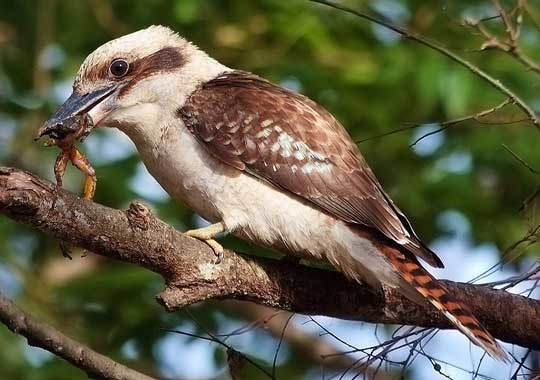
Kookaburras are cool birds, but some Australian farmers aren't too fond of them because kookaburras have a fondness for killing and eating baby chicks and ducklings.
It's a family affair. Kookaburras are monogamous (they choose one mate and stick together for a long time). They make their nests in holes in trees, laying up to five eggs. The eggs and hatched young are cared for not only by the parents but also by some of the siblings from previous clutches of eggs. So there could be seven or more kookaburras taking care of the young. Many of these sibling helpers will stay around to help for four years. These family groups get together each dawn and dusk and let out their loud, raucous calls to mark their territory.

Kookaburras hunt by sitting perfectly still on a branch and watching for prey. But sometimes a breeze will make the branch sway. No problem. Kookaburras are capable of keeping their heads perfectly still while the branch moves so that they can better spot small movements on the ground. This motionless head and swaying body make them look like a reverse bobblehead.
I grew up in Kansas, in the center of the US, thousands of miles from where kookaburras live. Yet I remember in school we would learn and sing the song, Kookaburra. This is a popular nursery rhyme and round, which apparently is taught to children around the world. It was written in 1932 by Marion Sinclair, a music teacher in Melbourne.
As harmless as this song seems, its history has included considerable controversy. For example, in 2009, Larrikin Music (the copyright holder of the song) sued the Australian band Men at Work, claiming that part of the song Down Under (the flute portion) was a rip-off of the Kookaburra song. After almost a year, the court ruled against Men at Work. And then, in 2010, there was a big social media controversy when a primary school directory told students to change the words, "Gay your life must be" to "Fun your life must be."
Now, when you look for the lyrics, you'll find a variety of different lines ("What a life you lead," "Sing your song for me," and others).
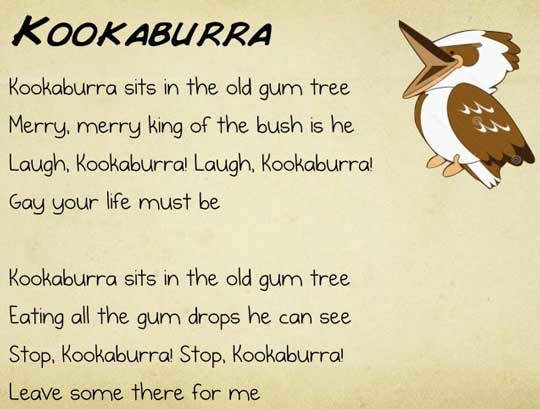
So, the Kookaburra deserves a place in the D.A.H.O.F. (Dynamite Animal Hall of Fame).
FUN FACT: The word dynamite was first introduced by A.B. Nobel, who invented dynamite. At some point in the 20th century, the word became a popular expression for anything spectacular. This use of the word is no doubt best known from the TV show, Good Times (1974 to 1979). In every episode, the character J.J. (played by Jimmy Walker) would say, "Dy-no-mite!" So, dynamite is another way to say awesome!
Photo Credits:
Laughing Kookaburra #1 - Stan C. Smith
Kookaburras with Frog - Richard Taylor, Wikimedia Commons
Young Kookaburras - Tilgate Nature Centre
Kookaburra Song - West View Music Lessons
So what the heck is a Kookaburra ?
Kookaburras are birds in the kingfisher family. They are the largest of the kingfishers, growing up to 17 inches (42 cm) long. There are four species of kookaburras, the most well-known of which is the laughing kookaburra. The kookaburra, like the wombat and the kangaroo, is an iconic animal of Australia, and it is worth knowing more about. Here is a laughing kookaburra Trish and I saw while on a walk:

Amazing facts about the Kookaburra
Perhaps the most striking characteristic of kingfishers is their vocalizations, and the kookaburra is king (and queen) of the kingfishers in this respect. The laughing kookaburra (which is the species we saw in northeast Queensland) is famous for its astoundingly-loud "laughing" call. On our trip to Australia, even if we had wanted to sleep past daybreak, the kookaburras would not have allowed it. At first light, they seem to get the overwhelming urge to let everything within a half mile know that they still haven't lost their sense of humor. Because of their regularity, they are sometimes called the bushman's clock.
Check out this video of a kookaburra laughing.
And this one!
Of course, they aren't really laughing when they do this. Instead, they are letting other birds know the boundaries of their territory. Kingfishers, in general, are territorial.
The kookaburra is a predator with an impressive, boat-shaped beak, up to four inches (10 cm) long. Although most of the other species of kingfishers live near water and prey on fish, kookaburras often live far from water, and they typically kill and eat insects, lizards, frogs, snakes (even venomous snakes), rodents, and smaller birds. Here's one with a frog.

Kookaburras are cool birds, but some Australian farmers aren't too fond of them because kookaburras have a fondness for killing and eating baby chicks and ducklings.
It's a family affair. Kookaburras are monogamous (they choose one mate and stick together for a long time). They make their nests in holes in trees, laying up to five eggs. The eggs and hatched young are cared for not only by the parents but also by some of the siblings from previous clutches of eggs. So there could be seven or more kookaburras taking care of the young. Many of these sibling helpers will stay around to help for four years. These family groups get together each dawn and dusk and let out their loud, raucous calls to mark their territory.

Kookaburras hunt by sitting perfectly still on a branch and watching for prey. But sometimes a breeze will make the branch sway. No problem. Kookaburras are capable of keeping their heads perfectly still while the branch moves so that they can better spot small movements on the ground. This motionless head and swaying body make them look like a reverse bobblehead.
I grew up in Kansas, in the center of the US, thousands of miles from where kookaburras live. Yet I remember in school we would learn and sing the song, Kookaburra. This is a popular nursery rhyme and round, which apparently is taught to children around the world. It was written in 1932 by Marion Sinclair, a music teacher in Melbourne.
As harmless as this song seems, its history has included considerable controversy. For example, in 2009, Larrikin Music (the copyright holder of the song) sued the Australian band Men at Work, claiming that part of the song Down Under (the flute portion) was a rip-off of the Kookaburra song. After almost a year, the court ruled against Men at Work. And then, in 2010, there was a big social media controversy when a primary school directory told students to change the words, "Gay your life must be" to "Fun your life must be."
Now, when you look for the lyrics, you'll find a variety of different lines ("What a life you lead," "Sing your song for me," and others).

So, the Kookaburra deserves a place in the D.A.H.O.F. (Dynamite Animal Hall of Fame).
FUN FACT: The word dynamite was first introduced by A.B. Nobel, who invented dynamite. At some point in the 20th century, the word became a popular expression for anything spectacular. This use of the word is no doubt best known from the TV show, Good Times (1974 to 1979). In every episode, the character J.J. (played by Jimmy Walker) would say, "Dy-no-mite!" So, dynamite is another way to say awesome!
Photo Credits:
Laughing Kookaburra #1 - Stan C. Smith
Kookaburras with Frog - Richard Taylor, Wikimedia Commons
Young Kookaburras - Tilgate Nature Centre
Kookaburra Song - West View Music Lessons
Published on June 12, 2018 05:37
June 10, 2018
Awesome Animal - Camelops
Okay, for today's Awesome Animal, it seems appropriate to feature an animal that plays an important role in
Bridgers 2
(which is being released on June15!). When our bridgers arrive in their new alternate version of Earth, they find themselves in the midst of a herd of large, hump-backed, drooling, lip-smacking creatures that resemble the camelops, which happens to be extinct on our own version of Earth.
So what the heck is a Camelops ?
As you can probably tell by the name, the camelops was a type of camel. These critters were quite large, standing over seven feet tall at the shoulder and weighing 1,800 pounds (800 kg). They roamed over most of western North America, appearing about three to four million years ago and finally going extinct very recently (about 11,000 years ago).

Amazing facts about Camelops (and Camels)
Most people think of camels being in the deserts of Asia and Africa. But actually, camels (and their close relatives, llamas) originated in North America about 44 million years ago. By the way, horses originated in North America, too. Camels and horses gradually migrated to Asia over the Bering Strait (which, of course, is now underwater).
We don't know if the camelops had a hump on its back. Why? Because everything we understand about these extinct animals comes from fossils. The hump on a camel's back is made of soft tissue (not bone), and soft tissue is rarely preserved in fossils. So, they may have had humps, like the modern camels, or they may have been humpless, like their other close relatives, llamas. The result of this is that some artists create them with long fur and humps, and others create them with short fur and no humps:
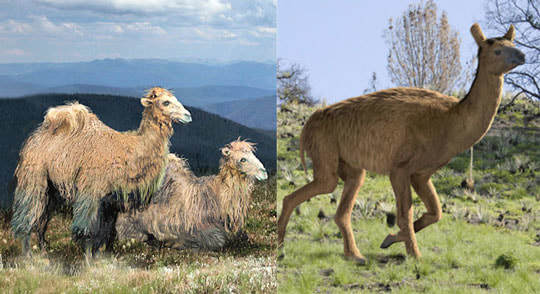
The camelops was highly adapted for running and traveling great distances in open grasslands. Based upon fossilized tracks of early camels and upon bone structure, we know that they had a distinctive "pacing gait," in which the two legs on each side move at the same time (the two right legs move forward, then the two left legs). This gait is very efficient, allowing long-distance travel with less energy consumption.
These camels liked to hang out with early horses and bison. Their fossils are often found together. Maybe this was because there was more safety from predators in large numbers. Or maybe simply because they liked to graze on the same plants.
We don't know for sure why the camelops went extinct. It happened at about the same time that many other large North American mammals disappeared, including the mastodon, horses, llamas, and many others. This mass extinction could have been the result of climate change. But many scientists think it may have been caused by the spread of humans that hunted big game. Humans migrated to North America across the Bering Strait and then spread out to the south and east. These humans are known to have used spears with sharpened stone tips, as well as other stone tools. There is still little definitive evidence that humans caused the extinction, but it seems very likely.
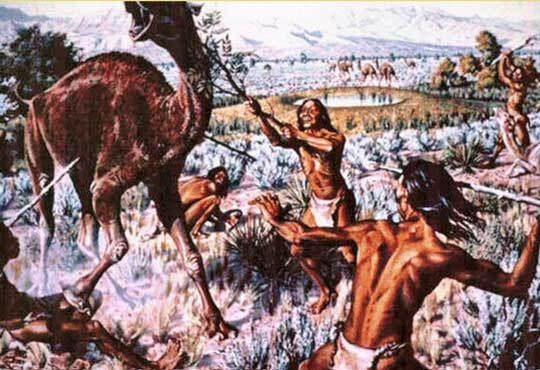
Another thing we're uncertain about regarding camelops anatomy is the mouth and throat. The males of today's Arabian camel (also called the dromedary) have a strangely modified soft palate that they can hang out the side of their mouth when they are ready to mate. This astoundingly grotesque structure is called a dulla, and the females find it irresistible, especially when accompanied by massive drooling and a loud grunting vocalization.
Check out this video of a camel extending its dulla!
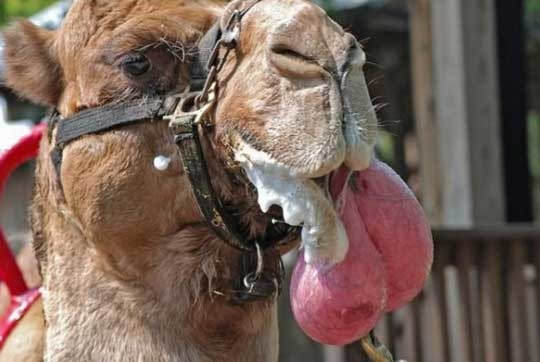
Anyway, since the dulla is a soft body part, we don't really know if the male camelops had these.
The word camel comes from the Arabic word, gml, which has the literal meaning, beauty . Hmm... whoever came up with the name probably wasn't looking at a camel with its dulla hanging out.
Speaking of the dromedary (Arabian camel), these camels once lived in the wild in and near the Sahara Desert. But they were domesticated in the Somalia area about 4,000 years ago, and by 2,000 years ago, there were no more dromedaries living naturally in the wild. Oddly, though, in 1840, dromedaries were imported into Australia to be used as work animals in the dry areas of the outback. Over the decades, some of these camels were released into the wild, and now the population of feral camels is estimated at 300,000 to over 600,000. This is currently the only population of breeding dromedaries exhibiting wild behavior in the world.
The photo below is of an Australian prospector riding a camel that held a world record for distance traveled without once drinking water. How far? Six hundred miles!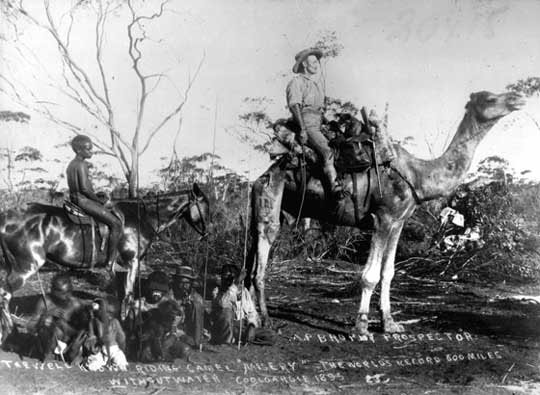
So, the Camelops (and camels in general) deserves a place in the W.A.H.O.F. (Wicked Animal Hall of Fame).
FUN FACT: The word wicked first meant, well... wicked (evil or morally bad). But in the last few decades younger people have started using it to mean wonderful, great, or masterful (as in, "I passed my biology exam. Wicked!"). It can also be used as an adverb to add emphasis to whatever you're describing, such as, "That's wicked cool!" So, wicked is another way to say awesome!
Photo Credits:
Camelops Digital Rendering #1 - Philip Edwin
Camelops with Hump (left image) - Canadian Museum of Nature
Camelops without hump (right image) - Pinterest
Native Americans hunting Camelops - Paleonet
Camel dulla - Clay Walker via Digital Journal
So what the heck is a Camelops ?
As you can probably tell by the name, the camelops was a type of camel. These critters were quite large, standing over seven feet tall at the shoulder and weighing 1,800 pounds (800 kg). They roamed over most of western North America, appearing about three to four million years ago and finally going extinct very recently (about 11,000 years ago).

Amazing facts about Camelops (and Camels)
Most people think of camels being in the deserts of Asia and Africa. But actually, camels (and their close relatives, llamas) originated in North America about 44 million years ago. By the way, horses originated in North America, too. Camels and horses gradually migrated to Asia over the Bering Strait (which, of course, is now underwater).
We don't know if the camelops had a hump on its back. Why? Because everything we understand about these extinct animals comes from fossils. The hump on a camel's back is made of soft tissue (not bone), and soft tissue is rarely preserved in fossils. So, they may have had humps, like the modern camels, or they may have been humpless, like their other close relatives, llamas. The result of this is that some artists create them with long fur and humps, and others create them with short fur and no humps:

The camelops was highly adapted for running and traveling great distances in open grasslands. Based upon fossilized tracks of early camels and upon bone structure, we know that they had a distinctive "pacing gait," in which the two legs on each side move at the same time (the two right legs move forward, then the two left legs). This gait is very efficient, allowing long-distance travel with less energy consumption.
These camels liked to hang out with early horses and bison. Their fossils are often found together. Maybe this was because there was more safety from predators in large numbers. Or maybe simply because they liked to graze on the same plants.
We don't know for sure why the camelops went extinct. It happened at about the same time that many other large North American mammals disappeared, including the mastodon, horses, llamas, and many others. This mass extinction could have been the result of climate change. But many scientists think it may have been caused by the spread of humans that hunted big game. Humans migrated to North America across the Bering Strait and then spread out to the south and east. These humans are known to have used spears with sharpened stone tips, as well as other stone tools. There is still little definitive evidence that humans caused the extinction, but it seems very likely.

Another thing we're uncertain about regarding camelops anatomy is the mouth and throat. The males of today's Arabian camel (also called the dromedary) have a strangely modified soft palate that they can hang out the side of their mouth when they are ready to mate. This astoundingly grotesque structure is called a dulla, and the females find it irresistible, especially when accompanied by massive drooling and a loud grunting vocalization.
Check out this video of a camel extending its dulla!

Anyway, since the dulla is a soft body part, we don't really know if the male camelops had these.
The word camel comes from the Arabic word, gml, which has the literal meaning, beauty . Hmm... whoever came up with the name probably wasn't looking at a camel with its dulla hanging out.
Speaking of the dromedary (Arabian camel), these camels once lived in the wild in and near the Sahara Desert. But they were domesticated in the Somalia area about 4,000 years ago, and by 2,000 years ago, there were no more dromedaries living naturally in the wild. Oddly, though, in 1840, dromedaries were imported into Australia to be used as work animals in the dry areas of the outback. Over the decades, some of these camels were released into the wild, and now the population of feral camels is estimated at 300,000 to over 600,000. This is currently the only population of breeding dromedaries exhibiting wild behavior in the world.
The photo below is of an Australian prospector riding a camel that held a world record for distance traveled without once drinking water. How far? Six hundred miles!

So, the Camelops (and camels in general) deserves a place in the W.A.H.O.F. (Wicked Animal Hall of Fame).
FUN FACT: The word wicked first meant, well... wicked (evil or morally bad). But in the last few decades younger people have started using it to mean wonderful, great, or masterful (as in, "I passed my biology exam. Wicked!"). It can also be used as an adverb to add emphasis to whatever you're describing, such as, "That's wicked cool!" So, wicked is another way to say awesome!
Photo Credits:
Camelops Digital Rendering #1 - Philip Edwin
Camelops with Hump (left image) - Canadian Museum of Nature
Camelops without hump (right image) - Pinterest
Native Americans hunting Camelops - Paleonet
Camel dulla - Clay Walker via Digital Journal
Published on June 10, 2018 05:45
May 16, 2018
Awesome Animal - Bush Stone-Curlew
For your reading pleasure today, I am featuring the Bush Stone-Curlew as the awesome animal. Why? Two reasons. First, because today is the release date of y new novel,
Bridgers 1: The Lure of Infinity
. Bridgers 1 is filled with strange birds, and the bush stone-curlew is definitely a strange bird. Second, we saw stone-curlews on our Australia trip, and I think they are, well, simply awesome.
So what the heck is a Bush Stone-Curlew ?
The Bush Stone-curlew is a rather strange-looking bird with extremely long legs and large eyes. It is a predatory bird that lives in all but the driest areas of Australia, although it has decreased significantly in recent decades. Here is a photo of one of the bush stone-curlews we saw in northeast Australia:

Amazing facts about Bush Stone-Curlews
Stone-curlews are primarily predators. They hunt in areas where there are fallen leaves and sticks they can sort through and small logs they can pick apart. They do this to find a variety of insects, lizards, small snakes, crabs, and even rodents. They hunt mainly at night, which is why their eyes are so large (looking similar in some ways to owl eyes).
Stone-curlews love to stare at their own reflections. This is an unusual behavior that has been observed on many occasions. In fact, stone-curlews have become brief social media stars when photos of them staring into windows have gone viral. Often they will become so transfixed with their own reflection that they will return to the same window day after day, standing motionless and staring for hours each day. This behavior can probably be explained by several facts. First, stone-curlews have a defense strategy that involves standing or squatting motionless. Perhaps when they see their reflection, they think it is another bird and they freeze. It could be a variation of the common bahavior of birds fighting with themselves in the mirror. Anyway, the photo below is a stone-curlew that kept returning to this window so regularly that a volunteer with Wildcare Australia put up this sign (it says: "I’m a bush stone curlew. I’m fine. I just like to stare at myself in the window.").

Stone-curlews are rarely seen doing their courtship behaviors. Why? Because once they find a mate, they stay paired together for life... as long as 30 years! Their courtship behavior must be spectacular to see because those people who have been lucky enough to witness it have described it as a "glee party" and a "whistling concert."
Speaking of the stone-curlew's call, these birds have sometimes been nicknamed the "screaming woman bird." Their call is a high, mournful, piercing shriek. This may be why aboriginal Australians have associated the bird with suicide and death.
Check out this video of a stone-curlew calling.
Curlews can also growl or hiss. When Trish and I came upon three stone-curlews at the edge of a soccer field, I tried to approach them to get a better photo. They responded by growling at me. This is a common behavior when they feel threatened.
Check out this video of a growling curlew.
As another means of defense, the stone-curlew will often freeze, apparently attempting to blend in with its background. The thing is, it tends to freeze immediately, even when it is currently in a strange position. So if you see a dead-still curlew standing on one leg or squatting, this is why. See photo below.

Although stone-curlews have declined in much of their range (endangered in New South Wales, threatened in Victoria), they adapt very well to human presence in Queensland (northeast Australia). In Brisbane, they inhabit the shopping districts, hanging out without moving near shrubbery during the day, rarely noticed by all the people. And at night they happily feed on the insects and geckos that congregate around the bright lights. They have even been seen collecting cigarette butts and lining their nests with them, possibly because the nicotine acts as an insect repellent.
Speaking of their nests, when stone-curlews feel that their nests are being threatened, they often spread their wings and raise a noisy ruckus to scare aware potential predators. See photo.

So, the bush stone-curlew deserves a place in the G.A.H.O.F. (Gnarly Animal Hall of Fame).
FUN FACT: The word gnarly first meant bumpy or twisted (as in, he has gnarly fingers). Eventually (particularly in surfing) it became a word to describe something very difficult or bad (he had a gnarly wipeout on that wave). And then finally, it came to mean very good. As in, that dude can do some gnarly guitar playing! So gnarly is another way to say awesome!
Photo Credits:
Stone Curlew #1 - Stan C. Smith
Stone-curlew staring at reflection - ABC News
Stone-curlew freezing - David Cook - Canberra Birds
Stone-curlew in threatening posture - Land for Wildlife
So what the heck is a Bush Stone-Curlew ?
The Bush Stone-curlew is a rather strange-looking bird with extremely long legs and large eyes. It is a predatory bird that lives in all but the driest areas of Australia, although it has decreased significantly in recent decades. Here is a photo of one of the bush stone-curlews we saw in northeast Australia:

Amazing facts about Bush Stone-Curlews
Stone-curlews are primarily predators. They hunt in areas where there are fallen leaves and sticks they can sort through and small logs they can pick apart. They do this to find a variety of insects, lizards, small snakes, crabs, and even rodents. They hunt mainly at night, which is why their eyes are so large (looking similar in some ways to owl eyes).
Stone-curlews love to stare at their own reflections. This is an unusual behavior that has been observed on many occasions. In fact, stone-curlews have become brief social media stars when photos of them staring into windows have gone viral. Often they will become so transfixed with their own reflection that they will return to the same window day after day, standing motionless and staring for hours each day. This behavior can probably be explained by several facts. First, stone-curlews have a defense strategy that involves standing or squatting motionless. Perhaps when they see their reflection, they think it is another bird and they freeze. It could be a variation of the common bahavior of birds fighting with themselves in the mirror. Anyway, the photo below is a stone-curlew that kept returning to this window so regularly that a volunteer with Wildcare Australia put up this sign (it says: "I’m a bush stone curlew. I’m fine. I just like to stare at myself in the window.").

Stone-curlews are rarely seen doing their courtship behaviors. Why? Because once they find a mate, they stay paired together for life... as long as 30 years! Their courtship behavior must be spectacular to see because those people who have been lucky enough to witness it have described it as a "glee party" and a "whistling concert."
Speaking of the stone-curlew's call, these birds have sometimes been nicknamed the "screaming woman bird." Their call is a high, mournful, piercing shriek. This may be why aboriginal Australians have associated the bird with suicide and death.
Check out this video of a stone-curlew calling.
Curlews can also growl or hiss. When Trish and I came upon three stone-curlews at the edge of a soccer field, I tried to approach them to get a better photo. They responded by growling at me. This is a common behavior when they feel threatened.
Check out this video of a growling curlew.
As another means of defense, the stone-curlew will often freeze, apparently attempting to blend in with its background. The thing is, it tends to freeze immediately, even when it is currently in a strange position. So if you see a dead-still curlew standing on one leg or squatting, this is why. See photo below.

Although stone-curlews have declined in much of their range (endangered in New South Wales, threatened in Victoria), they adapt very well to human presence in Queensland (northeast Australia). In Brisbane, they inhabit the shopping districts, hanging out without moving near shrubbery during the day, rarely noticed by all the people. And at night they happily feed on the insects and geckos that congregate around the bright lights. They have even been seen collecting cigarette butts and lining their nests with them, possibly because the nicotine acts as an insect repellent.
Speaking of their nests, when stone-curlews feel that their nests are being threatened, they often spread their wings and raise a noisy ruckus to scare aware potential predators. See photo.

So, the bush stone-curlew deserves a place in the G.A.H.O.F. (Gnarly Animal Hall of Fame).
FUN FACT: The word gnarly first meant bumpy or twisted (as in, he has gnarly fingers). Eventually (particularly in surfing) it became a word to describe something very difficult or bad (he had a gnarly wipeout on that wave). And then finally, it came to mean very good. As in, that dude can do some gnarly guitar playing! So gnarly is another way to say awesome!
Photo Credits:
Stone Curlew #1 - Stan C. Smith
Stone-curlew staring at reflection - ABC News
Stone-curlew freezing - David Cook - Canberra Birds
Stone-curlew in threatening posture - Land for Wildlife
Published on May 16, 2018 13:51
May 5, 2018
Awesome Animal - Wombat
Trish and I are now wrapping up our Australian adventure. We spent a few days in Cairns, and one of the first orders of business was to hike the Blue Arrow trail at Mt. Whitfield Conservation Park. Why? Because this trail, as well as the last living cassowary to roam Mt. Whitfield park, were the inspiration for the title of my novella,
Blue Arrow
. Trish and I hiked this trail 23 years ago on a previous trip, back when the last Mt. Whitfield cassowary (also named Blue Arrow) was still alive. By the way, if you haven't read
Blue Arrow
, you're missing an important piece of the
Diffusion
series. It's an intriguing science fiction story, and it's a love story unlike any other.
If we look a little sweaty in this photo, it might be because we had just come from cold April days in Missouri to the warm tropics. Or... maybe because we aren't as young as we were 23 years ago!
Usually, I feature animals that appear in my books. But since Trish and I are currently exploring the northeast corner of Queensland, Australia, I've chosen an Awesome Animal that is an Australian icon. Nope, not a kangaroo... the WOMBAT!
So what the heck is a Wombat ?
Besides being one of the coolest-looking mammals ever, wombats are chunky, muscular marsupials that live mostly in southeast Australia (although there is an isolated population in Queensland). They are diggers. They use their powerful forelimbs to dig extensive burrows. And they are herbivores, eating grasses, other herbaceous plants, and plant roots. It seems to me that they are the Australian marsupial version of the woodchuck (a large, chunky rodent that is common in the US). There are three species of wombats: the northern hairy-nosed wombat, the southern hairy-nosed wombat, and the common wombat (also known as the bare-nosed wombat).
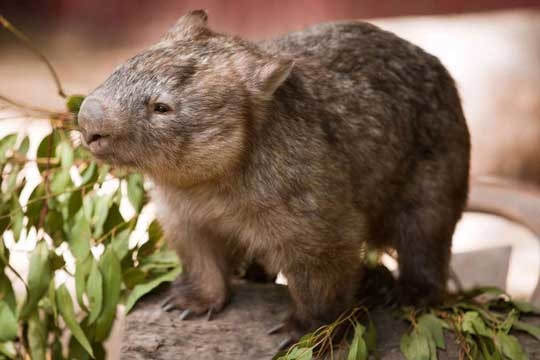
Amazing facts about Wombats
Wombats like to dig. In fact, they can be destructive (as woodchucks can be in the midwest US). In 1906, the Australian government declared wombats to be pests and encouraged people to kill as many as they could. Bounties were even paid for the skins. Although that practice has stopped, the future of these creatures is uncertain, due to land clearing, habitat competition with cattle, roadkill, and other factors. The hairy-nosed wombat is almost extinct, with only about 100 individuals remaining in one National Park in Queensland.
Wombats might be larger than you think. The common wombat typically weighs between 32 and 80 pounds (14 to 36 kg). The largest known wombat was Patrick. Patrick was a common wombat that lived its entire life at Ballarat Wildlife Park in Victoria, Australia. Patrick lived to 31 years of age and weighed a whopping 88 pounds (40 kg). Patrick was so popular that he had a Facebook page with 56,000 followers. Unfortunately, Patrick died in April of 2017. See photo of Patrick below.
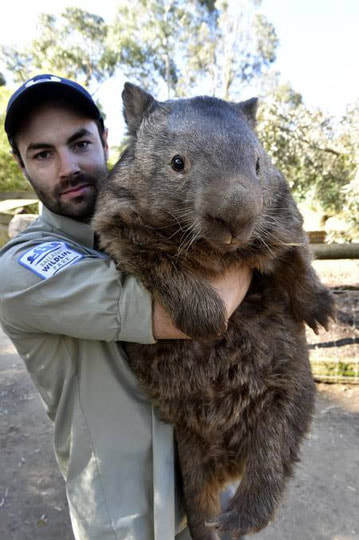
Wombats reproduce slowly. Females give birth to only one baby (called a joey) every two years. Like other marsupials, the babies develop outside the body instead of inside. A wombat joey is born the size of a jellybean, and then it crawls to the mother's pouch and attaches to a nipple. In the pouch, it will grow for six months before it even detaches from the nipple and peeks out at the world. It stays in the pouch for up to 10 months, and it continues to return to the mother to feed for up to 15 months (which I suppose is why they have only one baby every two years). Now, here's the really unusual part. You know how kangaroo pouches are on the front side of the mother kangaroo? Well, wombat pouches open up to the rear. This is to prevent dirt from filling up the pouch as the mother digs.
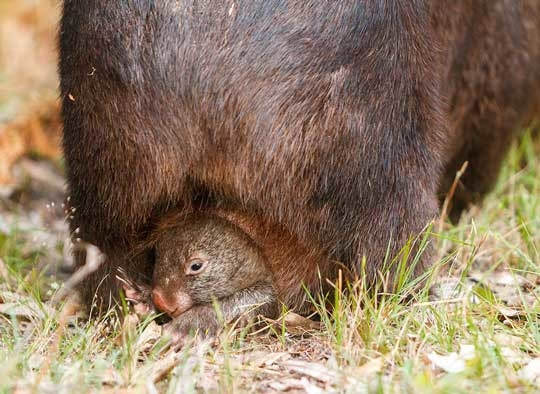
Wombats produce cubic poop. Yep, you read that right. They poop out square poo. Why? Well, it has to do with how wombats use their poo. Wombats are territorial, and they mark their territories by leaving chunks of poo in carefully-selected places. Often they leave chunks on top of rocks and logs so that other wombats will find them more easily. So... it is thought that the poo is square so that it will not roll out of place. If the poo rolls out of place, the other wombats may not find it, and then the wombats will get into a nasty fight. And no one wants that to happen, right?
Check out this brief video that explains wombat square poo.
Wombats have big, tough butts. The reason why? because of dingoes, foxes, and Tasmanian devils. These are the main predators of wombats. And when a wombat is being attacked, it will dive headfirst into a tunnel and block the opening with its rear end. Wombats have really thick, tuff skin on their butts. So tough, in fact, that predators can rarely chew through it.
The wombat's rather large rear end has become somewhat of a cultural thing. For example, a statue called Fatso the Fat-Arsed Wombat became the "unofficial" mascot of the 2000 Sydney Olympics. Fatso appeared on top of a pole outside Sydney's Stadium Australia. See photo below.

So, the wombat deserves a place in the B.A.H.O.F. (Blastastic Animal Hall of Fame).
FUN FACT: The word Blastastic is a mash-up of fantastic and blast. As in, "I had a blastastic time last night!" I'm not sure when this term was first used, but there is a computer game called Blastastic Love Story, and I found several other references to the word. That's enough to convince me the word is real. Besides, I like the way it sounds. So blastastic is another way to say awesome!
Photo Credits:
Wombat on log - Australian Reptile Park
Patrick, the oldest Wombat - Reddit Pics
Wombat Joey in Pouch - San Diego Zoo
Fatso the Fat-Arsed Wombat - Wikipedia
If we look a little sweaty in this photo, it might be because we had just come from cold April days in Missouri to the warm tropics. Or... maybe because we aren't as young as we were 23 years ago!

Usually, I feature animals that appear in my books. But since Trish and I are currently exploring the northeast corner of Queensland, Australia, I've chosen an Awesome Animal that is an Australian icon. Nope, not a kangaroo... the WOMBAT!
So what the heck is a Wombat ?
Besides being one of the coolest-looking mammals ever, wombats are chunky, muscular marsupials that live mostly in southeast Australia (although there is an isolated population in Queensland). They are diggers. They use their powerful forelimbs to dig extensive burrows. And they are herbivores, eating grasses, other herbaceous plants, and plant roots. It seems to me that they are the Australian marsupial version of the woodchuck (a large, chunky rodent that is common in the US). There are three species of wombats: the northern hairy-nosed wombat, the southern hairy-nosed wombat, and the common wombat (also known as the bare-nosed wombat).

Amazing facts about Wombats
Wombats like to dig. In fact, they can be destructive (as woodchucks can be in the midwest US). In 1906, the Australian government declared wombats to be pests and encouraged people to kill as many as they could. Bounties were even paid for the skins. Although that practice has stopped, the future of these creatures is uncertain, due to land clearing, habitat competition with cattle, roadkill, and other factors. The hairy-nosed wombat is almost extinct, with only about 100 individuals remaining in one National Park in Queensland.
Wombats might be larger than you think. The common wombat typically weighs between 32 and 80 pounds (14 to 36 kg). The largest known wombat was Patrick. Patrick was a common wombat that lived its entire life at Ballarat Wildlife Park in Victoria, Australia. Patrick lived to 31 years of age and weighed a whopping 88 pounds (40 kg). Patrick was so popular that he had a Facebook page with 56,000 followers. Unfortunately, Patrick died in April of 2017. See photo of Patrick below.

Wombats reproduce slowly. Females give birth to only one baby (called a joey) every two years. Like other marsupials, the babies develop outside the body instead of inside. A wombat joey is born the size of a jellybean, and then it crawls to the mother's pouch and attaches to a nipple. In the pouch, it will grow for six months before it even detaches from the nipple and peeks out at the world. It stays in the pouch for up to 10 months, and it continues to return to the mother to feed for up to 15 months (which I suppose is why they have only one baby every two years). Now, here's the really unusual part. You know how kangaroo pouches are on the front side of the mother kangaroo? Well, wombat pouches open up to the rear. This is to prevent dirt from filling up the pouch as the mother digs.

Wombats produce cubic poop. Yep, you read that right. They poop out square poo. Why? Well, it has to do with how wombats use their poo. Wombats are territorial, and they mark their territories by leaving chunks of poo in carefully-selected places. Often they leave chunks on top of rocks and logs so that other wombats will find them more easily. So... it is thought that the poo is square so that it will not roll out of place. If the poo rolls out of place, the other wombats may not find it, and then the wombats will get into a nasty fight. And no one wants that to happen, right?
Check out this brief video that explains wombat square poo.
Wombats have big, tough butts. The reason why? because of dingoes, foxes, and Tasmanian devils. These are the main predators of wombats. And when a wombat is being attacked, it will dive headfirst into a tunnel and block the opening with its rear end. Wombats have really thick, tuff skin on their butts. So tough, in fact, that predators can rarely chew through it.
The wombat's rather large rear end has become somewhat of a cultural thing. For example, a statue called Fatso the Fat-Arsed Wombat became the "unofficial" mascot of the 2000 Sydney Olympics. Fatso appeared on top of a pole outside Sydney's Stadium Australia. See photo below.

So, the wombat deserves a place in the B.A.H.O.F. (Blastastic Animal Hall of Fame).
FUN FACT: The word Blastastic is a mash-up of fantastic and blast. As in, "I had a blastastic time last night!" I'm not sure when this term was first used, but there is a computer game called Blastastic Love Story, and I found several other references to the word. That's enough to convince me the word is real. Besides, I like the way it sounds. So blastastic is another way to say awesome!
Photo Credits:
Wombat on log - Australian Reptile Park
Patrick, the oldest Wombat - Reddit Pics
Wombat Joey in Pouch - San Diego Zoo
Fatso the Fat-Arsed Wombat - Wikipedia
Published on May 05, 2018 02:10
April 13, 2018
Awesome Animal - Dung Beetle
Often I feature animals that appear in my books, and this is no exception. In my novel,
Savage
, Samuel Inwood has several interesting encounters with "scarab beetles," which is the family that includes dung beetles. And since I think dung beetles are so fascinating, I'm excited to tell you about them!
So what the heck is a Dung Beetle ?
Well, simply stated, dung beetles are beetles that like dung. They seriously like dung. They like it so much that they either eat dung exclusively or just part-time (kind of like I'm a part-time vegetarian). They live world-wide (except for Antarctica). They are broad, stocky beetles in the family, Scarabaeidae (scarab beetles). And... did I mention that they like dung? A few years ago, Trish and I were hiking in the Flint Hills of eastern Kansas (midwest USA). We came across this extremely busy beetle, working very hard to roll his prized dung ball through the grass to some unknown destination (my photo of it is below). Since then, I have become a fan of these little guys.
Amazing facts about Dung Beetles
There are 8,000 known species of dung beetles, and they are categorized based upon the way they use dung. They belong to three groups: rollers, tunnelers, and dwellers. You guessed it, the rollers carve out a piece of dung from a larger pile, shape it into a ball, and roll it away. Then they bury it somewhere so they have a snack for later, or so they can lay their eggs in it, thus providing a first yummy meal to their young. The tunnelers burrow into the ground beneath the larger dung pile and simply pull some of the dung down into their hole. And finally, the dwellers burrow into the large dung pile and set up residence within the pile itself.
A dung beetle walks into a bar... "Is this stool taken?"
Sorry, that was a crappy pun.
Ancient Egyptians were apparently very fond of dung beetles. One of their myths was that a giant dung beetle kept the Earth revolving like a huge ball of dung. So they linked dung beetles to Khepri, the Egyptian god of the rising sun. Due to people's fascination with ancient Egypt, scarab beetles are now often seen in jewelry and other types of ornamentation.
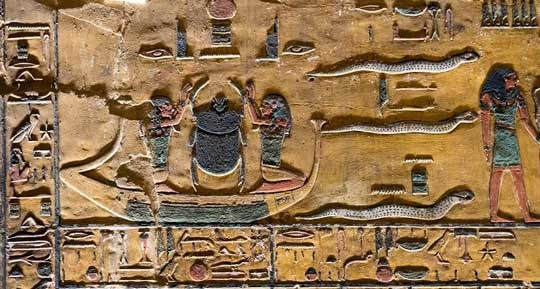
Although dung beetles don't look very aerodynamic, they are actually good flyers. They fly around searching for nice piles of dung. As they fly, they can use their antennae to catch a whiff of fresh dung from a considerable distance. They prefer fresh dung, as it is easier to burrow into or roll into a ball.
Dung beetles are strong. In fact, they are thought to be the strongest insect in the world. They can easily roll a dung ball ten times their own weight. And one species, Onthophagus taurus, can pull up to 1,141 times its own weight! This is the equivalent of an average-sized human pulling an object that weighs 205,000 pounds (93,000 kg). That's about the weight of 100 Toyota Corollas. Well, now I feel like a wimpy weakling.
There are two reasons these beetles are so strong. First, they have to move dung! Second, the males often fight over the females. If a male enters a tunnel looking for a female and there is already another male there, then the two males lock horns and get into a pushing match until the stronger one pushes the other away. This is why many of the scarab beetles have impressive horns.
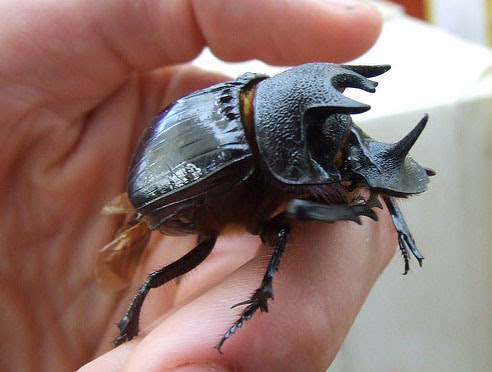
When a male and female have a chance encounter at a local dung pile, they will often form a pair bond. Then they work together to carve out a nice dung ball, and they either work together to roll it away, or the female will simply ride on top while the male pushes the ball. But often another male will come along and try to steal a dung ball. So, if you see two dung beetles rolling a dung ball together in the same direction, it is likely a bonded pair. If you see two (or three) struggling to push it in different directions, there are two males fighting over the dung ball.
Check out this BBC video on dung beetles (includes a silly way of showing how the males fight over dung balls).

Dung beetles are amazing navigators! One species (Scarabaeus zambesianus) is the only animal known to be able to navigate using the polarization patterns of moonlight. And according to recent studies in Africa, dung beetles can actually navigate based on the position of the Milky Way galaxy! They can move in a straight line relative to the orientation of the Milky Way's bright streak across the night sky. Wow!

So, the dung beetle deserves a place in the S.A.H.O.F. (Scrumtrulescent Animal Hall of Fame).
FUN FACT: The word Scrumtrulescent was first used by Will Farrell in 2001, in a Saturday Night Live episode called "Inside the Actor's Studio." Since then, it has caught on (kind of) as a word that means: so great that any other word employed would be woefully insufficient. So it is another (new) way to say awesome!
Photo Credits:
Dung beetle in the grass - Stan C. Smith
Dung beetle in Egyptian Hieroglyph - KairoInfo4U on Flickr
Horned Scarab Beetle - Carl Huchzermeyer on Flickr
Two Dung beetles on dung ball - AfricaGeographic
Dung Beetle and Milky Way Galaxy - Pinterest
So what the heck is a Dung Beetle ?
Well, simply stated, dung beetles are beetles that like dung. They seriously like dung. They like it so much that they either eat dung exclusively or just part-time (kind of like I'm a part-time vegetarian). They live world-wide (except for Antarctica). They are broad, stocky beetles in the family, Scarabaeidae (scarab beetles). And... did I mention that they like dung? A few years ago, Trish and I were hiking in the Flint Hills of eastern Kansas (midwest USA). We came across this extremely busy beetle, working very hard to roll his prized dung ball through the grass to some unknown destination (my photo of it is below). Since then, I have become a fan of these little guys.

Amazing facts about Dung Beetles
There are 8,000 known species of dung beetles, and they are categorized based upon the way they use dung. They belong to three groups: rollers, tunnelers, and dwellers. You guessed it, the rollers carve out a piece of dung from a larger pile, shape it into a ball, and roll it away. Then they bury it somewhere so they have a snack for later, or so they can lay their eggs in it, thus providing a first yummy meal to their young. The tunnelers burrow into the ground beneath the larger dung pile and simply pull some of the dung down into their hole. And finally, the dwellers burrow into the large dung pile and set up residence within the pile itself.
A dung beetle walks into a bar... "Is this stool taken?"
Sorry, that was a crappy pun.
Ancient Egyptians were apparently very fond of dung beetles. One of their myths was that a giant dung beetle kept the Earth revolving like a huge ball of dung. So they linked dung beetles to Khepri, the Egyptian god of the rising sun. Due to people's fascination with ancient Egypt, scarab beetles are now often seen in jewelry and other types of ornamentation.

Although dung beetles don't look very aerodynamic, they are actually good flyers. They fly around searching for nice piles of dung. As they fly, they can use their antennae to catch a whiff of fresh dung from a considerable distance. They prefer fresh dung, as it is easier to burrow into or roll into a ball.
Dung beetles are strong. In fact, they are thought to be the strongest insect in the world. They can easily roll a dung ball ten times their own weight. And one species, Onthophagus taurus, can pull up to 1,141 times its own weight! This is the equivalent of an average-sized human pulling an object that weighs 205,000 pounds (93,000 kg). That's about the weight of 100 Toyota Corollas. Well, now I feel like a wimpy weakling.
There are two reasons these beetles are so strong. First, they have to move dung! Second, the males often fight over the females. If a male enters a tunnel looking for a female and there is already another male there, then the two males lock horns and get into a pushing match until the stronger one pushes the other away. This is why many of the scarab beetles have impressive horns.

When a male and female have a chance encounter at a local dung pile, they will often form a pair bond. Then they work together to carve out a nice dung ball, and they either work together to roll it away, or the female will simply ride on top while the male pushes the ball. But often another male will come along and try to steal a dung ball. So, if you see two dung beetles rolling a dung ball together in the same direction, it is likely a bonded pair. If you see two (or three) struggling to push it in different directions, there are two males fighting over the dung ball.
Check out this BBC video on dung beetles (includes a silly way of showing how the males fight over dung balls).

Dung beetles are amazing navigators! One species (Scarabaeus zambesianus) is the only animal known to be able to navigate using the polarization patterns of moonlight. And according to recent studies in Africa, dung beetles can actually navigate based on the position of the Milky Way galaxy! They can move in a straight line relative to the orientation of the Milky Way's bright streak across the night sky. Wow!

So, the dung beetle deserves a place in the S.A.H.O.F. (Scrumtrulescent Animal Hall of Fame).
FUN FACT: The word Scrumtrulescent was first used by Will Farrell in 2001, in a Saturday Night Live episode called "Inside the Actor's Studio." Since then, it has caught on (kind of) as a word that means: so great that any other word employed would be woefully insufficient. So it is another (new) way to say awesome!
Photo Credits:
Dung beetle in the grass - Stan C. Smith
Dung beetle in Egyptian Hieroglyph - KairoInfo4U on Flickr
Horned Scarab Beetle - Carl Huchzermeyer on Flickr
Two Dung beetles on dung ball - AfricaGeographic
Dung Beetle and Milky Way Galaxy - Pinterest
Published on April 13, 2018 17:23
March 23, 2018
Awesome Animal - Terror Bird
The first book in my new series,
Bridgers
, will be released soon, so today's Awesome Animal comes from this book (sort of). I don't want to provide spoilers, so I'll just say that our heroes bridge to a world where they encounter some unusual birds. A lot of unusual birds. These are birds that don't exist, and never have existed, on our own version of Earth. But, there are a few extinct birds that lived on our version of Earth that are somewhat close. Including the
Terror Bird
.
So what the heck is a Terror Bird ?
These were large flightless birds that lived in South America (and a few of them moved up into North America) between 62 million years ago and 15,000 years ago (although some evidence suggests they only survived until 1.8 million years ago). They were huge, fast, and vicious predators. We have found evidence of about 25 species of terror birds.

Amazing facts about Terror Birds
Terror birds were big! They ranged in size from 3.3 to 9.8 feet (1 to 3 meters) tall. It is thought that the larger ones weighed at least 330 pounds (150 kg). In fact, the largest bird skull that has ever been found was a terror bird skull, 28 inches (71 cm) long, with a wicked-looking predator beak that was 18 inches (46 cm) long.
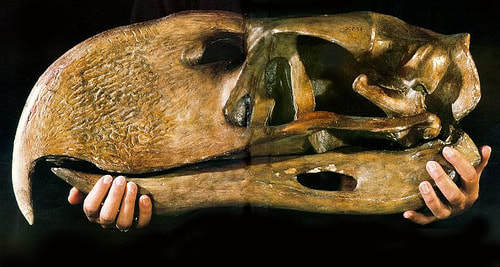
Terror bird is an appropriate name for these creatures. They must have struck terror into the mammals that they preyed on. They had clawed wings that were more like arms. They had huge talons (hind feet) that were probably very powerful. They almost definitely grabbed their prey in with their huge beaks, but CT scans of their skulls indicate that they couldn't swing their prey side to side with much force. They had much more power in their up and down motion, and therefore it is thought that they killed their prey by grabbing the creatures in their massive jaws and bashing them into the ground repeatedly until they were dead. Today, seriemas, roadrunners, and secretary birds still practice this feeding technique.
And they were fast. Based on the birds' size and the structure of their bones, scientists believe they could run at least 35 miles per hour (56 km/h). It is possible that these birds sometimes ate large mammals, but most likely they commonly ate rabbit-sized creatures that were easier and less dangerous to kill.
Check out this fun Discovery Channel video about terror birds.
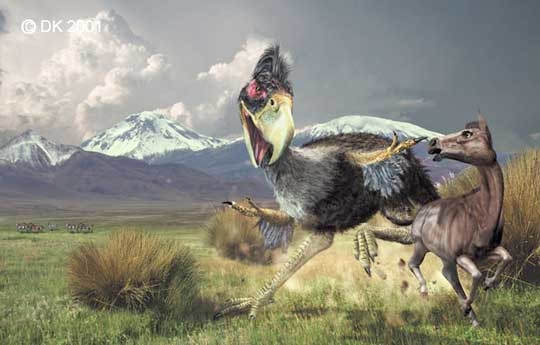
Scientists are pretty sure there is a descendant of terror birds still living today. It is called the Seriema . There are two species, and they live in South America (where most of the terror birds once lived). They stand a little less than a meter tall (35 inches). They can fly for short distances, but they typically hunt while running. They even escape predators by running, and they can run fast. Like their terror bird ancestors did, they chase down prey, such as insects, lizards, snakes, frogs, birds, and rodents. See photo below.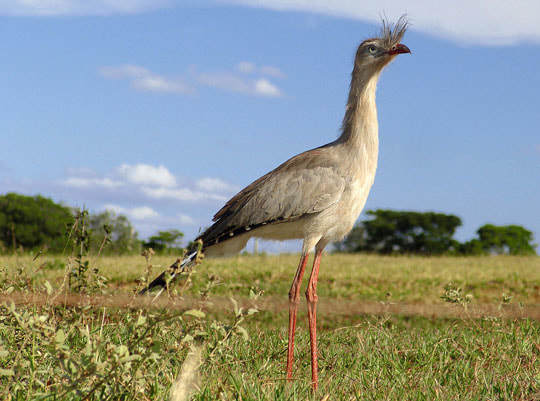
So, the terror bird deserves a place in the U.A.H.O.F. (Unreal Animal Hall of Fame).
FUN FACT: The word unreal was first used in about 1600. It originally meant not real, imaginary, or fanciful. But much more recently, particularly in North America, it began to be used with a meaning more like amazing or wonderful (as in, "This pasta salad is unreal!"). So it is another way to say awesome!
Photo Credits:
Terror Bird digital portrait - Darin Horley/ArtStation
Terror Bird skull - Scientific American, February 1994
Terror Bird chasing early horse - © 2001 Dorling Kindersley
Sireima - Wikipedia
So what the heck is a Terror Bird ?
These were large flightless birds that lived in South America (and a few of them moved up into North America) between 62 million years ago and 15,000 years ago (although some evidence suggests they only survived until 1.8 million years ago). They were huge, fast, and vicious predators. We have found evidence of about 25 species of terror birds.

Amazing facts about Terror Birds
Terror birds were big! They ranged in size from 3.3 to 9.8 feet (1 to 3 meters) tall. It is thought that the larger ones weighed at least 330 pounds (150 kg). In fact, the largest bird skull that has ever been found was a terror bird skull, 28 inches (71 cm) long, with a wicked-looking predator beak that was 18 inches (46 cm) long.

Terror bird is an appropriate name for these creatures. They must have struck terror into the mammals that they preyed on. They had clawed wings that were more like arms. They had huge talons (hind feet) that were probably very powerful. They almost definitely grabbed their prey in with their huge beaks, but CT scans of their skulls indicate that they couldn't swing their prey side to side with much force. They had much more power in their up and down motion, and therefore it is thought that they killed their prey by grabbing the creatures in their massive jaws and bashing them into the ground repeatedly until they were dead. Today, seriemas, roadrunners, and secretary birds still practice this feeding technique.
And they were fast. Based on the birds' size and the structure of their bones, scientists believe they could run at least 35 miles per hour (56 km/h). It is possible that these birds sometimes ate large mammals, but most likely they commonly ate rabbit-sized creatures that were easier and less dangerous to kill.
Check out this fun Discovery Channel video about terror birds.

Scientists are pretty sure there is a descendant of terror birds still living today. It is called the Seriema . There are two species, and they live in South America (where most of the terror birds once lived). They stand a little less than a meter tall (35 inches). They can fly for short distances, but they typically hunt while running. They even escape predators by running, and they can run fast. Like their terror bird ancestors did, they chase down prey, such as insects, lizards, snakes, frogs, birds, and rodents. See photo below.

So, the terror bird deserves a place in the U.A.H.O.F. (Unreal Animal Hall of Fame).
FUN FACT: The word unreal was first used in about 1600. It originally meant not real, imaginary, or fanciful. But much more recently, particularly in North America, it began to be used with a meaning more like amazing or wonderful (as in, "This pasta salad is unreal!"). So it is another way to say awesome!
Photo Credits:
Terror Bird digital portrait - Darin Horley/ArtStation
Terror Bird skull - Scientific American, February 1994
Terror Bird chasing early horse - © 2001 Dorling Kindersley
Sireima - Wikipedia
Published on March 23, 2018 18:13
March 8, 2018
Awesome Animal - Japanese Spider Crab
Usually, I feature animals that make appearances in my novels. But this is a creature I want to tell you about simply because I saw one recently and thought it was impressive.
Last summer, Trish and I visited the Sea Life Aquarium in Kansas City. As we walked through a darkened area featuring invertebrates, we came across a Japanese spider crab. This creature had a leg span of at least ten feet! I took a few photos (see the first photo below) and knew I would eventually need to tell you about it.
So what the heck is a Japanese spider crab ?
The Japanese spider crab has the largest leg span of all of the arthropods (Arthropoda is the phylum that includes insects, spiders, crabs, lobsters, and other multi-legged creatures with exoskeletons). Japanese spider crabs live in the Pacific Ocean in the waters off the coast of the southern portion of Japan.
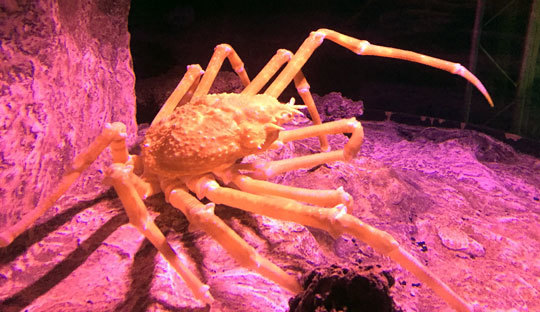
Amazing facts about Japanese Spider Crabs
These crabs are big! Japanese spider crabs can have a leg span of up to 14 feet (4.3 meters). That seems almost beyond belief, but you must realize that they have extremely long legs, so their size is mostly legs. Even so, the body is also impressive. The carapace can be up to 16 inches (40 cm) in diameter. The entire crab body and legs can weight up to 44 pounds (20 kg).
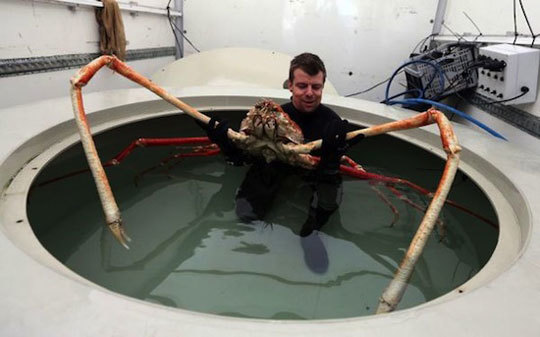
Japanese spider crabs live a long time. Well, actually, most crabs live quite a long time to begin with. You know those little hermit crabs you can buy in pet shops? Those critters can live sixty years! The Japanese spider crab is often reported to live 100 years, although I have had a hard time finding absolute proof of this, so perhaps it is only conjecture. But it certainly is possible, considering the creature's size and the long life of many other crabs.
They eat just about anything. Japanese spider crabs occassionally catch live prey, including mollusks and slow-moving invertebrates. But they seem to prefer dead creatures (they are scavengers), and their two long, powerful feeding claws can rip up just about any dead carcass they find on the ocean floor. Old mariner legends described these giant crabs dragging sailors into the water, drowning them, and then feeding on their bodies. Not true, of course, but these crabs certainly wouldn't hesitate to feast on the body of a sailor who has already drowned.

They generally live in deep water (150 to 300 meters down). But once per year, when they mate, they migrate into shallower water (about 50 meters). This is where their larvae hatch. Speaking of their larvae... in spite of the enormous size of the adult crabs, spider crab larvae are tiny and float around as plankton. In fact, if you've ever gone swimming off the coast of Japan, you have probably brushed up against thousands of Japanese spider crabs without even knowing it. The tiny larvae are extremely abundant. Why? Because females lay over a million eggs! See the spider crab larva below.

Unfortunately, Japanese spider crab numbers have dwindled in recent years due to overfishing. These unusual crabs are considered a delicacy. In Japan, fishermen are now prohibited from catching them during the breeding season, from January to April. Hopefully this will help increase the population.

Like other arthropods, Japanese spider crabs grow by periodically molting their exoskeleton, which is actually an amazing thing to watch.
Check out this time-lapse video of a molting spider crab
So, the Japanese spider crab deserves a place in the T.A.H.O.F. (Trill Animal Hall of Fame).
FUN FACT: The word trill is an amalgamation of the words "true" and "real." It is used mostly in the hip-hop community to describe someone who is successful and widely-respected. So basically, it is kinda, sorta another way to say awesome!
Photo Credits:
First spider crab photo - Stan C. Smith
Man in tank with spider crab - KidsDiscover
Spider Crab on Black Background - Wikimedia Commons
Spider Crab Larvae - ScienceBlogs
Cooking Spider Crabs - Pinterest
Last summer, Trish and I visited the Sea Life Aquarium in Kansas City. As we walked through a darkened area featuring invertebrates, we came across a Japanese spider crab. This creature had a leg span of at least ten feet! I took a few photos (see the first photo below) and knew I would eventually need to tell you about it.
So what the heck is a Japanese spider crab ?
The Japanese spider crab has the largest leg span of all of the arthropods (Arthropoda is the phylum that includes insects, spiders, crabs, lobsters, and other multi-legged creatures with exoskeletons). Japanese spider crabs live in the Pacific Ocean in the waters off the coast of the southern portion of Japan.

Amazing facts about Japanese Spider Crabs
These crabs are big! Japanese spider crabs can have a leg span of up to 14 feet (4.3 meters). That seems almost beyond belief, but you must realize that they have extremely long legs, so their size is mostly legs. Even so, the body is also impressive. The carapace can be up to 16 inches (40 cm) in diameter. The entire crab body and legs can weight up to 44 pounds (20 kg).

Japanese spider crabs live a long time. Well, actually, most crabs live quite a long time to begin with. You know those little hermit crabs you can buy in pet shops? Those critters can live sixty years! The Japanese spider crab is often reported to live 100 years, although I have had a hard time finding absolute proof of this, so perhaps it is only conjecture. But it certainly is possible, considering the creature's size and the long life of many other crabs.
They eat just about anything. Japanese spider crabs occassionally catch live prey, including mollusks and slow-moving invertebrates. But they seem to prefer dead creatures (they are scavengers), and their two long, powerful feeding claws can rip up just about any dead carcass they find on the ocean floor. Old mariner legends described these giant crabs dragging sailors into the water, drowning them, and then feeding on their bodies. Not true, of course, but these crabs certainly wouldn't hesitate to feast on the body of a sailor who has already drowned.

They generally live in deep water (150 to 300 meters down). But once per year, when they mate, they migrate into shallower water (about 50 meters). This is where their larvae hatch. Speaking of their larvae... in spite of the enormous size of the adult crabs, spider crab larvae are tiny and float around as plankton. In fact, if you've ever gone swimming off the coast of Japan, you have probably brushed up against thousands of Japanese spider crabs without even knowing it. The tiny larvae are extremely abundant. Why? Because females lay over a million eggs! See the spider crab larva below.

Unfortunately, Japanese spider crab numbers have dwindled in recent years due to overfishing. These unusual crabs are considered a delicacy. In Japan, fishermen are now prohibited from catching them during the breeding season, from January to April. Hopefully this will help increase the population.

Like other arthropods, Japanese spider crabs grow by periodically molting their exoskeleton, which is actually an amazing thing to watch.
Check out this time-lapse video of a molting spider crab
So, the Japanese spider crab deserves a place in the T.A.H.O.F. (Trill Animal Hall of Fame).
FUN FACT: The word trill is an amalgamation of the words "true" and "real." It is used mostly in the hip-hop community to describe someone who is successful and widely-respected. So basically, it is kinda, sorta another way to say awesome!
Photo Credits:
First spider crab photo - Stan C. Smith
Man in tank with spider crab - KidsDiscover
Spider Crab on Black Background - Wikimedia Commons
Spider Crab Larvae - ScienceBlogs
Cooking Spider Crabs - Pinterest
Published on March 08, 2018 19:31



